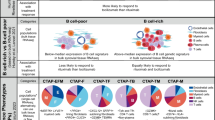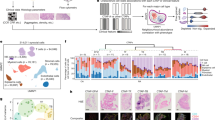Abstract
Purpose of Review
This review provides a summary of recent molecular findings that have refined our understanding of the cell types that constitute human synovial tissue, particularly in patients with rheumatoid arthritis (RA).
Recent Findings
Recent advances in high-dimensional and single-cell assays have elucidated upwards of 20 cell subsets in the RA synovium. This includes novel fibroblast populations and lymphocyte phenotypes, which in many cases exhibit features that have not been found in other tissues thus far.
Summary
Molecular profiling studies over the past several years have rapidly generated a comprehensive and detailed outline of the cellular phenotypes in synovial tissue affected by RA. Molecular features of these newly identified cell subsets immediately represent reasonable therapeutic targets and provide the opportunity to design the most clinically relevant mechanistic experiments. Broadly speaking, the ~ 20 cell types thus far identified in RA synovium seem to be fairly well conserved across patients, despite extensive heterogeneity in patient clinical features, stage of disease, and treatment responses. Thus, a next phase in molecular profiling may benefit from quantifying patient samples in terms of the ratios of cell types, with the rationale that certain cellular interactions will predominate in an individual and medications targeting these interactions may be more efficacious for that individual. Such cellular profiling in tissues combined with studies examining how the compendium of these cells interact in their three-dimensional tissue ultrastructures will be important in understanding how collectively these cells drive the disease process and ultimately how best to treat patients.


Similar content being viewed by others
Data Availability
The Zhang et al. AMP consortium synovial dataset can be accessed in a visualization tool or in raw downloadable files at https://immunogenomics.io/cellbrowser/, and https://portals.broadinstitute.org/single_cell/study/amp-phase-1.
References
Papers of particular interest, published recently, have been highlighted as: • Of importance •• Of major importance
Firestein GS, Gabriel SE, McInnes IB, et al.: Kelley and Firestein’s textbook of rheumatology. Amsterdam, Netherlands: Elsevier 2016, 10th edn.
Orr C, Vieira-Sousa E, Boyle DL, Buch MH, Buckley CD, Canete JD, et al. Synovial tissue research: a state-of-the-art review. Nat Rev Rheumatol. 2017;13:630.
Donlin LT, Park SH, Giannopoulou E, Ivovic A, Park-Min KH, Siegel RM, et al. Insights into rheumatic diseases from next-generation sequencing. Nat Rev Rheumatol. 2019;15:327–39.
• Stephenson W, Donlin LT, Butler A, Rozo C, Bracken B, Rashidfarrokhi A, et al. Single-cell RNA-seq of rheumatoid arthritis synovial tissue using low-cost microfluidic instrumentation. Nat Commun. 2018;9:791 Using an unbiased single-cell RNA-seq approach, this study identified 13 unique cell subsets in the synovium from RA patients.
•• Zhang F, Wei K, Slowikowski K, Fonseka CY, Rao DA, Kelly S, et al. Defining inflammatory cell states in rheumatoid arthritis joint synovial tissues by integrating single-cell transcriptomics and mass cytometry. Nat Immunol. 2019; Here the RA/SLE network within the Accelerating Medicines Partnership (AMP) consoritum collected synovial tissue from a large patient cohort and identified 18 unique cell subsets using single-cell RNA-seq, sorted bulk population RNA-seq and mass cytometry.
• Donlin LT, Rao DA, Wei K, Slowikowski K, McGeachy MJ, Turner JD, et al. Methods for high-dimensional analysis of cells dissociated from cryopreserved synovial tissue. Arthritis Res Ther. 2018;20:139 Here the AMP consortium describes their standardized methodology for synovial tissue dissociation and analysis with high-dimensional molecular assays.
Mor A, Abramson SB, Pillinger MH. The fibroblast-like synovial cell in rheumatoid arthritis: a key player in inflammation and joint destruction. Clin Immunol. 2005;115:118–28.
Muller-Ladner U, Kriegsmann J, Franklin BN, Matsumoto S, Geiler T, Gay RE, et al. Synovial fibroblasts of patients with rheumatoid arthritis attach to and invade normal human cartilage when engrafted into SCID mice. Am J Pathol. 1996;149:1607–15.
Slowikowski K, Wei K, Brenner MB, Raychaudhuri S. Functional genomics of stromal cells in chronic inflammatory diseases. Curr Opin Rheumatol. 2018;30:65–71.
Karpus ON, Kiener HP, Niederreiter B, Yilmaz-Elis AS, van der Kaa J, Ramaglia V, et al. CD55 deposited on synovial collagen fibers protects from immune complex-mediated arthritis. Arthritis Res Ther. 2015;17:6.
Lee DM, Kiener HP, Agarwal SK, Noss EH, Watts GF, Chisaka O, et al. Cadherin-11 in synovial lining formation and pathology in arthritis. Science. 2007;315:1006–10.
• Mizoguchi F, Slowikowski K, Wei K, Marshall JL, Rao DA, Chang SK, et al. Functionally distinct disease-associated fibroblast subsets in rheumatoid arthritis. Nat Commun. 2018;9:789 This study identified three unique fibroblast subsets in the synovium from RA patients using single-cell RNA-seq.
• Mandelin AM, 2nd, Homan PJ, Shaffer AM, Cuda CM, Dominguez ST, Bacalao E, Carns M, Hinchcliff M, Lee J, Aren K, et al.: Transcriptional profiling of synovial macrophages using minimally invasive ultrasound-guided synovial biopsies in rheumatoid arthritis. Arthritis Rheumatol 2018. This report describes a large-scale collection of synovial biopsies and transcriptomic analysis of synovial macrophages from patients with RA.
• Kuo D, Ding J, Cohn IS, Zhang F, Wei K, Rao DA, et al. HBEGF(+) macrophages in rheumatoid arthritis induce fibroblast invasiveness. Sci Transl Med. 2019;11 Phenotypic and functional characterization of the most prominent synovial macrophage subset found in RA patients using single-cell RNA-seq and ex vivo drug response assays.
• Wood MJ, Leckenby A, Reynolds G, Spiering R, Pratt AG, Rankin KS, et al. Macrophage proliferation distinguishes 2 subgroups of knee osteoarthritis patients. JCI Insight. 2019;4 Phenotypic and functional characterization of macrophage subsets from the synovium of patients with OA and inflammatory athritides.
• Canavan M, Walsh AM, Bhargava V, Wade SM, McGarry T, Marzaioli V, et al. Enriched Cd141+ DCs in the joint are transcriptionally distinct, activated, and contribute to joint pathogenesis. JCI Insight. 2018;3 Purification and functional characterization of CD141+dendritic cells from the synovium.
Villani AC, Satija R, Reynolds G, Sarkizova S, Shekhar K, Fletcher J, et al. Single-cell RNA-seq reveals new types of human blood dendritic cells, monocytes, and progenitors. Science. 2017;356:eaah4573.
• Rao DA, Gurish MF, Marshall JL, Slowikowski K, Fonseka CY, Liu Y, et al. Pathologically expanded peripheral T helper cell subset drives B cells in rheumatoid arthritis. Nature. 2017;542:110–4 Identification of the Tph T cell subset that is enriched in RA patient synovial tissue that supports local B cell antibody production.
• Christophersen A, Lund EG, Snir O, Sola E, Kanduri C, Dahal-Koirala S, et al. Distinct phenotype of CD4(+) T cells driving celiac disease identified in multiple autoimmune conditions. Nat Med. 2019;25:734–7.
Poli A, Michel T, Theresine M, Andres E, Hentges F, Zimmer J. CD56bright natural killer (NK) cells: an important NK cell subset. Immunology. 2009;126:458–65.
Ai R, Hammaker D, Boyle DL, Morgan R, Walsh AM, Fan S, et al. Joint-specific DNA methylation and transcriptome signatures in rheumatoid arthritis identify distinct pathogenic processes. Nat Commun. 2016;7:11849.
Acknowledgments
We thank E. DiCarlo and T. Pannellini for the synovial tissue histologic images. We also recognize the HSS FLARE multidisciplinary team in particular S. Goodman, E. Dicarlo, D. Orange, and L. Donlin for their input and education on synovial tissue and C. Rozo for editing of the review. Dr. Donlin reports grants from NIH, NIAMS, Ambrose Monell Foundation and the Leon Lowenstein Foundation.
Author information
Authors and Affiliations
Corresponding author
Ethics declarations
Conflict of Interest
Authors have nothing to disclose.
Human and Animal Rights and Informed Consent
This article does not contain any studies with human or animal subjects performed by any of the authors.
Additional information
Publisher’s Note
Springer Nature remains neutral with regard to jurisdictional claims in published maps and institutional affiliations.
This article is part of the Topical Collection on Rheumatoid Arthritis
Rights and permissions
About this article
Cite this article
Shanaj, S., Donlin, L.T. Synovial Tissue: Cellular and Molecular Phenotyping. Curr Rheumatol Rep 21, 52 (2019). https://doi.org/10.1007/s11926-019-0858-1
Published:
DOI: https://doi.org/10.1007/s11926-019-0858-1




